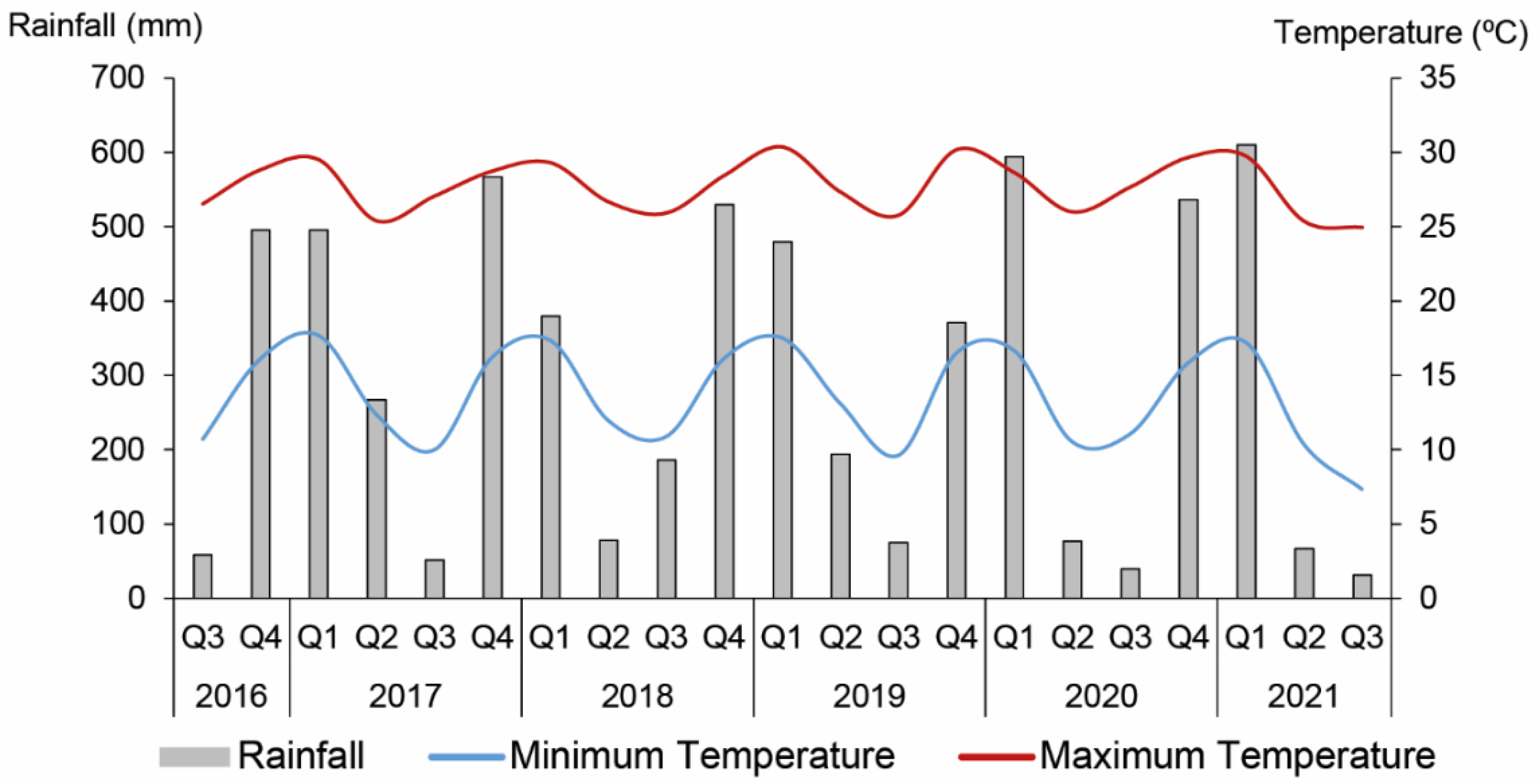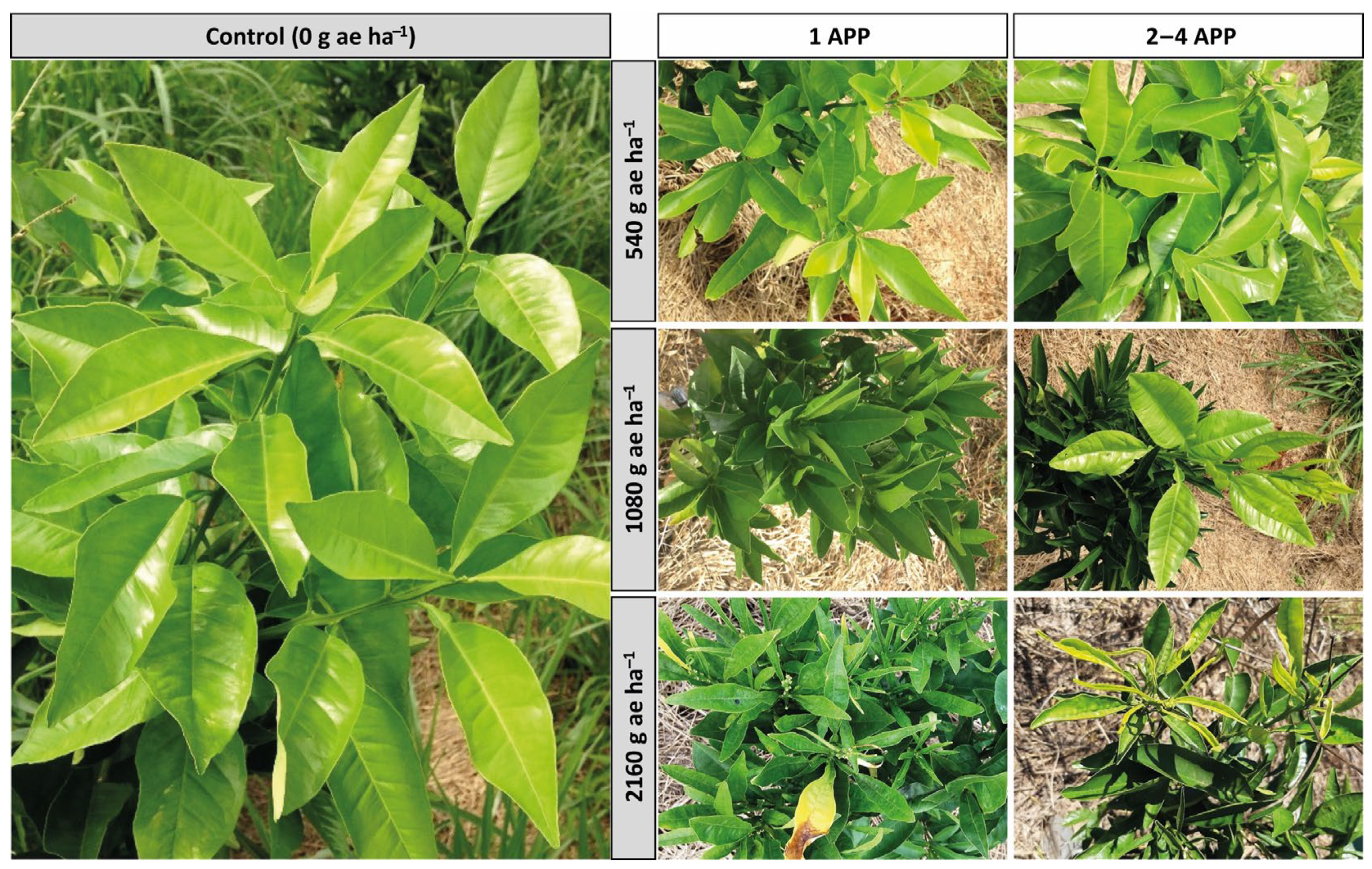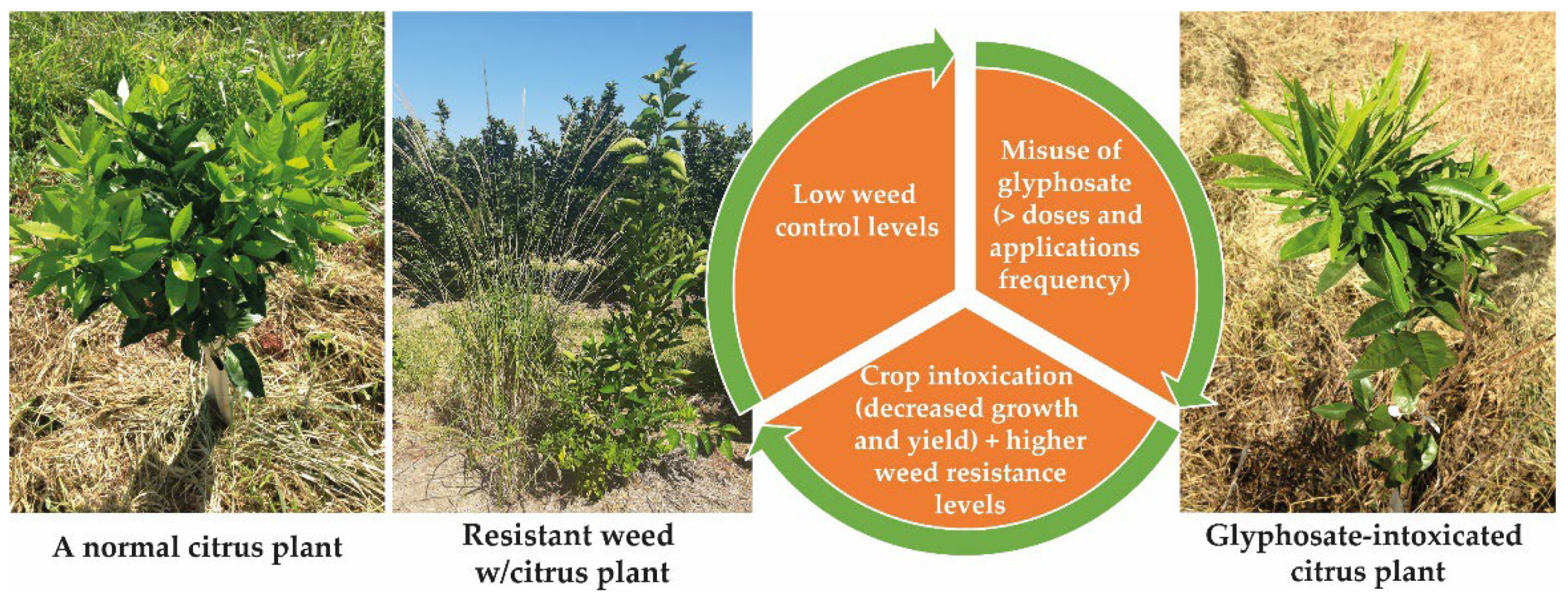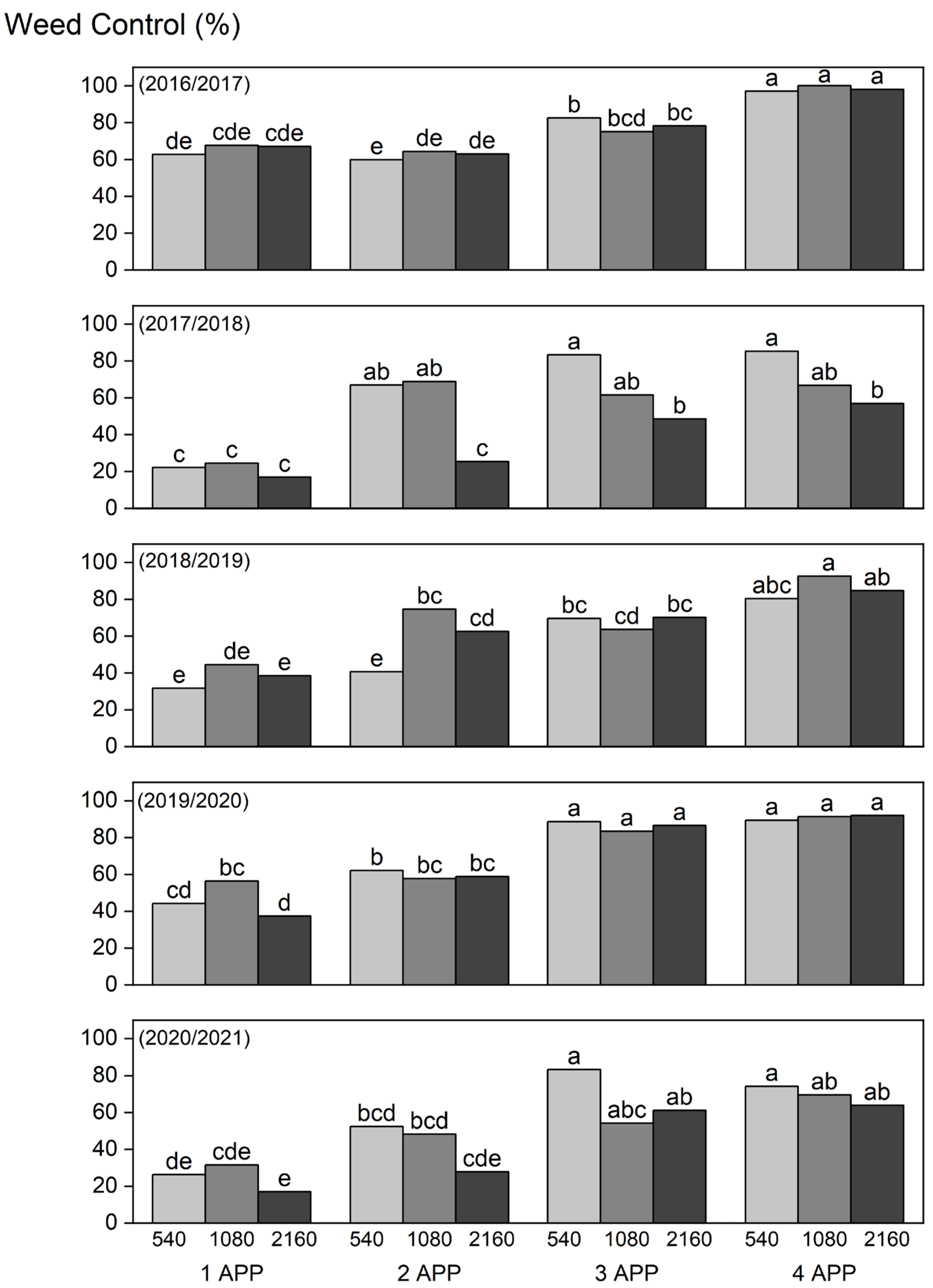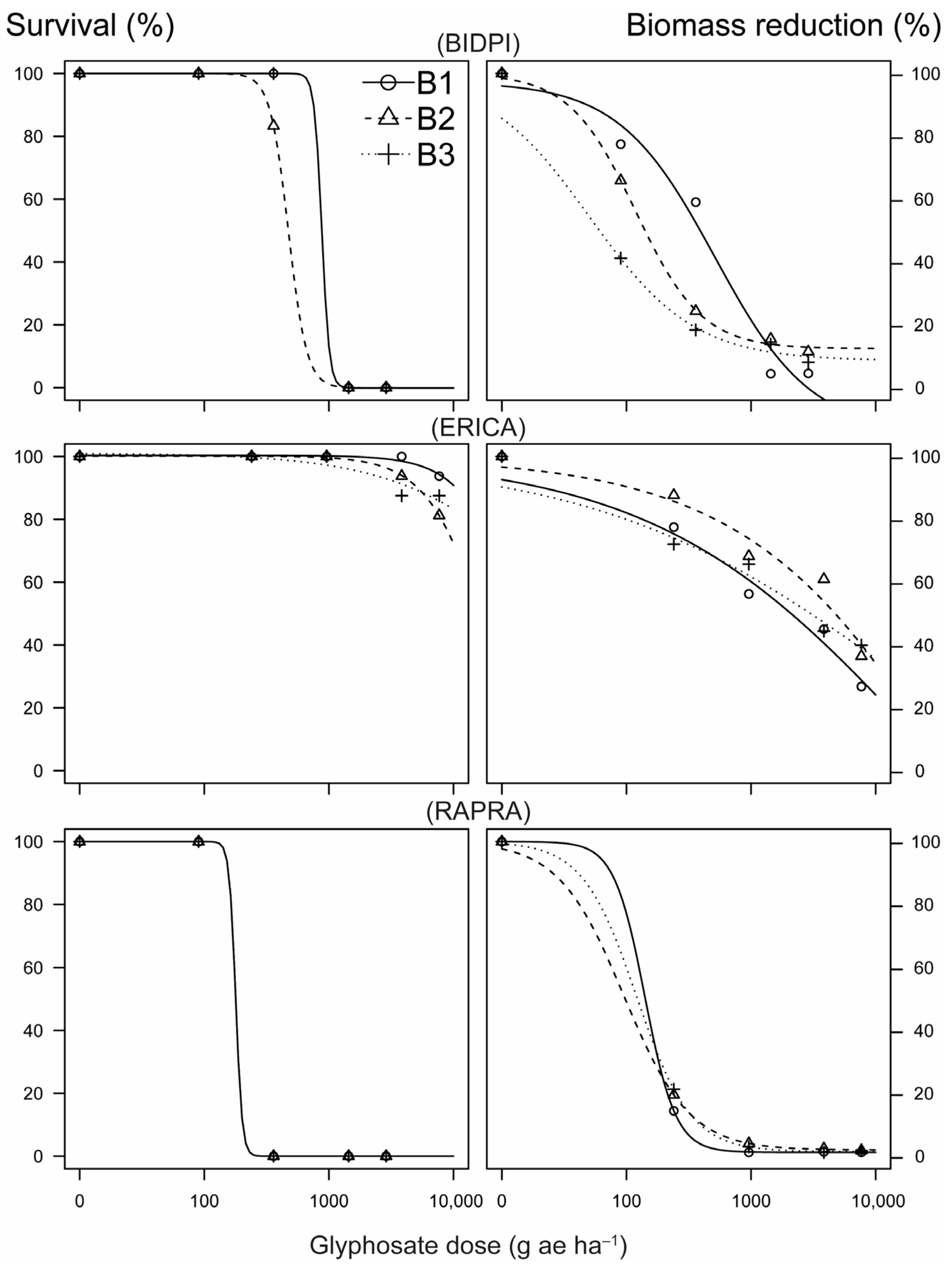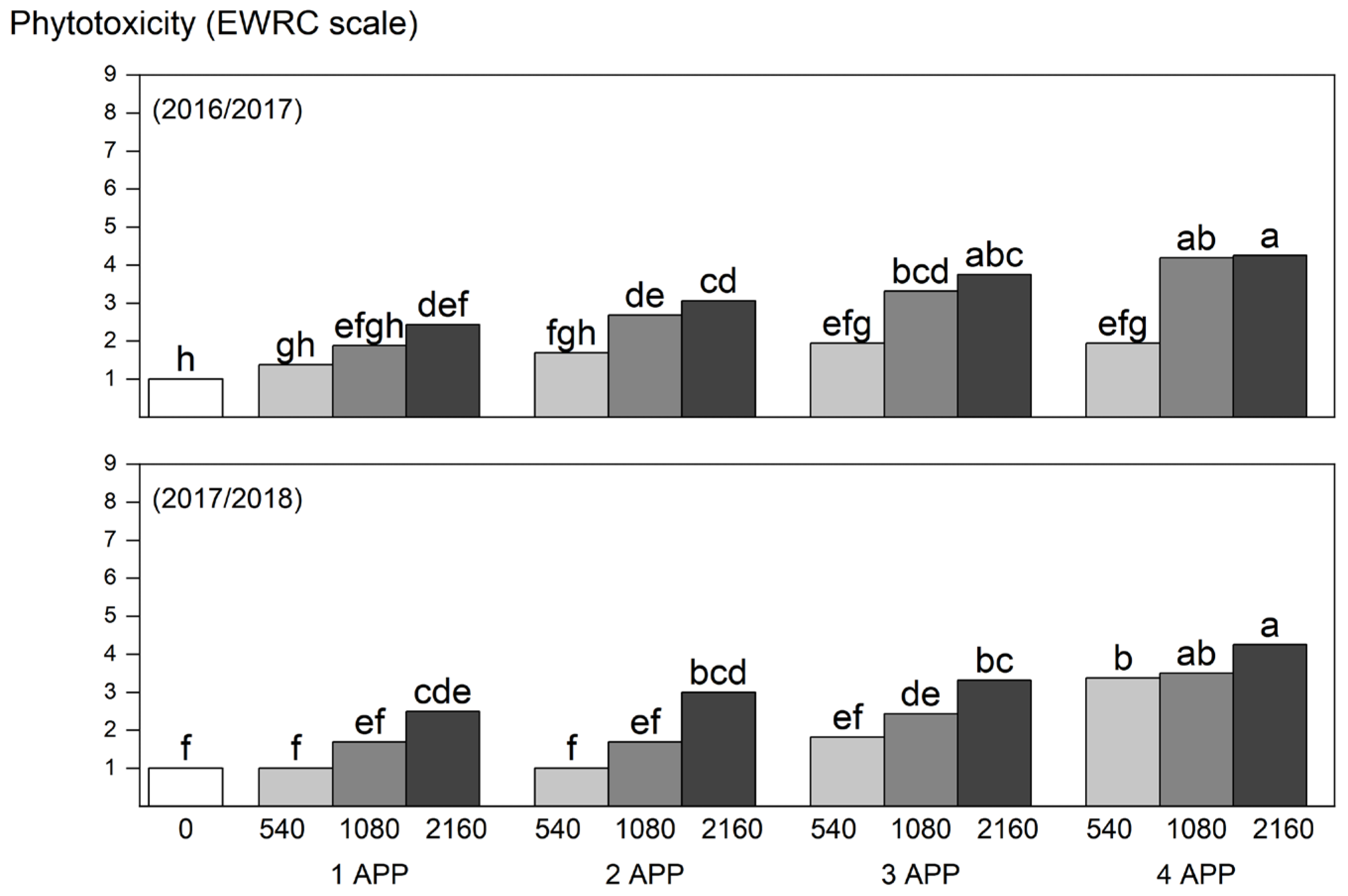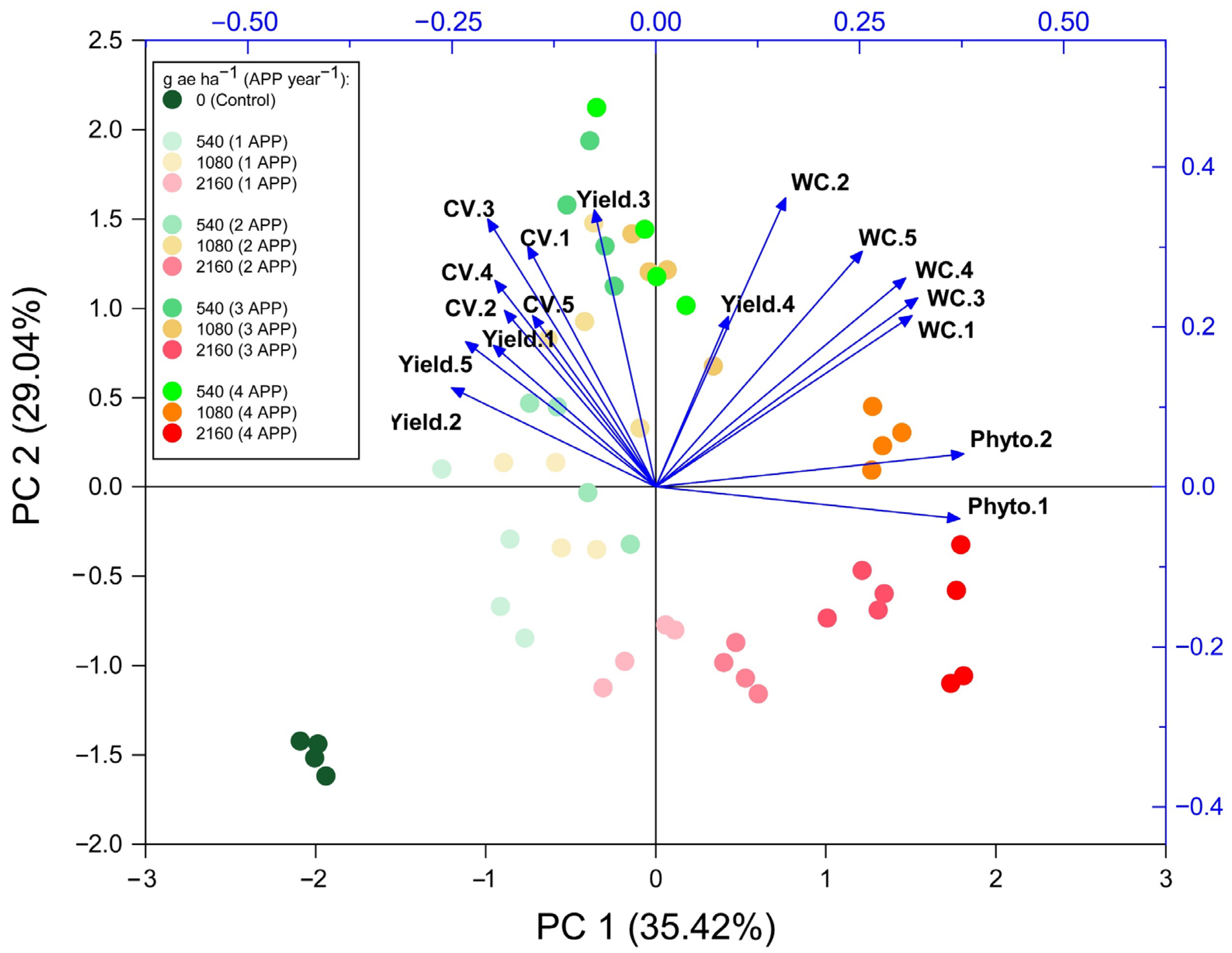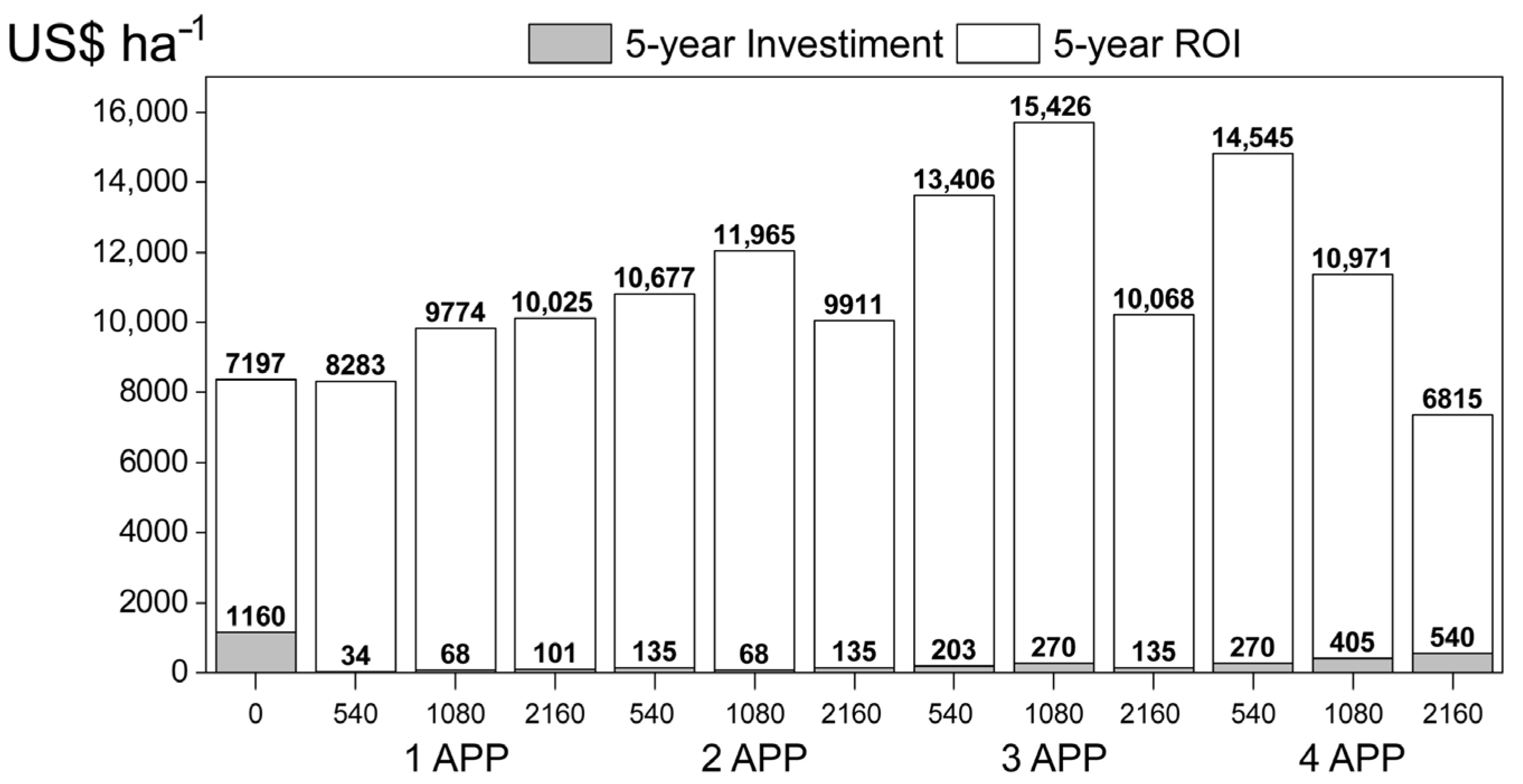1. Introduction
In perennial crops, such as citrus, weeds live at different phenological stages and at the same time and space with the crop throughout its cycle. Therefore, these crops have a smaller number of herbicides and control opportunities compared with the annual crops, where the control is often conducted in the cultivation intervals and/or using herbicide-resistant cultivars. Fruit crops have fewer herbicide options available, e.g., in Brazil, there are 22 active ingredients (ai) registered for citrus versus 50 ai for soybean, 49 ai for maize, and 52 ai for sugarcane [
1].
Chemical weed control is often preferred for Brazilian citrus growers and the majority uses only glyphosate (N-(phosphonomethyl) glycine). Moreover, its applications are usually directed to the planting line, under the canopy of the plants, but can be carried out throughout the inter-row of the orchard. Glyphosate is a non-selective herbicide that is translocated mainly to metabolic drains, which can be distant from the site of application. In addition, its mobile properties in phloem and slow action allow the herbicide to move throughout the plant to kill all the meristems, making it effective even for the control of perennial weeds [
2].
In 1974, this herbicide was launched and the applied worldwide volume of glyphosate-based herbicides (GBHs) increased very significantly (>100 times) [
3], mainly due to: (i) Its low cost; (ii) increasing application rates in response to weed biotypes resistant to this herbicide; (iii) the broad adoption of resistant cultivars (Roundup Ready
®); and (iv) to new usage patterns, such as preharvest, desiccation of cultivated or non-cultivated areas, etc.
In the case of citrus fruits, an increase in the use of glyphosate since its release was due to the control on efficiency and ease of use, which generates a good cost-to-benefit ratio. Due to precisely these characteristics,
Brazilian citrus growers used glyphosate as the only weed control tool. Therefore, with its intensive use, there was an increase in reports of low control efficacy, related to the selection of resistant weed species biotypes and the higher selection pressure on tolerant species. As a result, most of the citrus growers used glyphosate inappropriately (rather than the use of other herbicides), with increases in dosage and application frequency [
4], leading to a vicious circle (
Figure 1).
However, many growers do not consider and/or do not have access to two important glyphosate issues: (i) The possible phytointoxication of citrus plants by its contact, absorption, and translocation; and (ii) the increasing and continuous selection of resistant biotypes and tolerant species due to the lack of herbicide rotation with different mechanisms of action, as well as the absence of other weed control strategies, such as integrated weed management (IWM) programs.
In a weed management survey by citrus growers from several Brazilian producing regions, 98% responded that they use glyphosate and 36% do not use other herbicides. Among those who use glyphosate, 73% use dosages above 1000 g acid equivalent (ae) ha
−1: 56% between 1000 and 1500 g ae ha
−1, 6% from 1500 to 2000 g ae ha
−1, and 11% above 2000 g ae ha
−1. With regards to the spray frequency (application per growing season): 11% spray once, 47% spray twice, 22% spray three times, 9% spray four times, and 11% spray five or more times—there has been a report of up to 10 applications per growing season [
5]. However, the majority of interviewed farmers were medium to large citrus growers, and the lack of information for small growers can even worsen the problem.
With regards to the consequences of using glyphosate, there remains a significant amount of speculation. In addition, the published studies are not conclusive. The action mechanism of glyphosate is unique since it is the only herbicide that acts on the shikimic acid route. It has the capability to inhibit the enzyme EPSP synthase (5-enolpiruvil-chiquimate-3-phosphate-synthase) by competing with the binding site of the phosphoenolpyruvate substrate (PEP). This inhibits the formation of chorismate, which is a precursor to salicylic acid (plant defense hormone) and three aromatic amino acids (tryptophan (Trp), tyrosine (Tyr), and phenylalanine (Phe)). Chorismate serves as a precursor to a wide variety of aromatic compounds that have crucial roles in plant growth, development, reproduction, and defense [
6,
7]. Therefore, the accumulation of shikimic acid causes carbon drain, reducing the general functioning of other biochemical pathways. This route is responsible for up to 30% of the carbon fixed by photosynthesis, and up to 30% of the dry biomass of the plant [
8,
9].
As a result, the continuous use of glyphosate may result in crop damage over time due to the phytotoxicity caused by this herbicide can remain for up to 2 years. Glyphosate phytotoxicity in citrus is characterized by chlorosis, falling of preformed leaves, and malformation of shoots [
10], with significant losses for the citrus grower [
11]. Moreover, fruit fall was reported for distinct citrus varieties [
12]. However, previous studies have demonstrated little toxicity of glyphosate to citrus plants or even a transient effect of this phytointoxication [
13,
14,
15]. In these studies, the evaluations were carried out in a brief time. Therefore, no studies evaluated the effect of long-term glyphosate management in citrus orchards, in addition to the remaining reports of phytointoxication of citrus orchards.
As a result, it is hypothesized that the increase in dose and frequency of glyphosate application does not increase weed control but decreases the growth and production of citrus plants by phytointoxication with this herbicide over time, decreasing the financial return. This 5-year study aims to determine the implications of glyphosate management in citrus orchards, with different doses and application frequencies over five growing seasons. Here, we determine the weed control levels, and in citrus plants, the phytotoxicity levels to glyphosate by visual symptoms, growth, yield, and economic viability.
2. Materials and Methods
2.1. Experiment Installation
The experiment was conducted in an area previously installed in 2015, at Centro de Citricultura ‘Sylvio Moreira’ (Instituto Agronômico—IAC) in Cordeirópolis (22°27′35″ S, 47°24′27″ W, altitude of 712 m above sea level), State of São Paulo, Brazil, during five growing seasons (August to July: 2016/2017, 2017/2018, 2018/2019, 2019/2020, and 2020/2021). The on-site climate is classified as subtropical (Cwa) and humid, with dry winters (temperatures below 18 °C) and hot summers (temperatures above 22 °C) [
16]. Rainfall and temperature data during the experimental period were obtained from monitoring via a meteorological station installed 50 m away from the experiment (
Figure A1). The soil was classified as an Orthic Ferralsol (WRB/FAO) (oxisol—Rhodic Hapludox—U.S.D.A. Soil Taxonomy;
Latossolo Vermelho distrófico—Brazilian classification) with 64.6% clay, 21.3% sand, and 14.1% silt.
The experimental design used was randomized blocks with 13 treatments and four replications. The treatments were composed of different doses (540 to 2160 g ae ha−1) and application frequencies of glyphosate (1–4 applications per growing season (APP)) (Roundup Original®; 356 g ae L−1): T1: Control, no application; T2: 540 g ae ha−1 (1 APP); T3: 1080 g ae ha−1 (1 APP); T4: 2160 g ae ha−1 (1 APP); T5: 540 g ae ha−1 (2 APP); T6: 1080 g ae ha−1 (2 APP); T7: 2160 g ae ha−1 (2 APP); T8: 540 g ae ha−1 (3 APP); T9: 1080 g ae ha−1 (3 APP); T10: 2160 g ae ha−1 (3 APP); T11: 540 g ae ha−1 (4 APP); T12: 1080 g ae ha−1 (4 APP); T13: 2160 g ae ha−1 (4 APP). Additionally, the treatments with 1 APP were applied in October of each growing season, those with 2 APP were applied in October and December, those with 3 APP in October, December, and February, and those with 4 APP in October, December, February, and April.
The experimental area totaled 0.63 ha. The orchard was composed of Pêra sweet orange (Citrus sinensis (L.) Osbeck) grafted on tangerine Sunki (Citrus sunki (Hayata) hort. Tanaka). In addition, it was distributed in six rows with 70 plants each, totaling 420 plants spaced at 6.0 m (between planting lines, also known as inter-row) × 2.5 m (between plants, also known as intra-row or tree-row), and each experimental unit consisted of four citrus plants. The planting of the orchard was carried out in February 2015, with seedlings of 12 months of age, in a minimum cultivation system, with preparation only of the planting lines with subsoiling, furrowing, and planting fertilization.
Glyphosate was applied using a backpack CO2 sprayer, with a constant pressure of 2.0 bar, at 0.5 m from the soil surface. The application volume was 200 L ha−1, and the application bar was equipped with an anti-drift attachment, as well as Teejet® Air Induction Extended Range (AIXR) 11002 fan-type spray tips, with air induction technology to reduce the drift effect. The applications were carried out in the planting line of the orchard, in the width of the canopy of citrus plants (such as canopy projection), which is the main region of competition between the crop and the weeds. The first application of glyphosate was performed in October 2016, and the orchard was 1 year and 8 months old, with the stems fully lignified.
On the same application dates, the control plots (0 g ae ha−1) had weed control performed by the mechanical control, with a motorized manual mower. This option was used to simulate the non-chemical control, which is used by agricultural production systems in citrus orchards, given that manual weeding currently has no economic viability.
2.2. Weed Control
Weed infestation levels were evaluated 30 days after glyphosate application. The initial sample of 0.25 m2 quadrats was released eight times per repetition (sampling area = 2.0 m²) and directed to the weed control area (intra-row), which was identified and quantified according to the percentage of coverage of the sample area. Therefore, the weed control data were calculated using the coverage values of each treatment related to the control treatment values.
2.3. Glyphosate Susceptibility Levels of Weed Biotypes in the Experimental Area
Greenhouse bioassays of glyphosate application were carried out (also on Cordeirópolis, São Paulo State, Brazil) to determine the susceptibility of the dominant weeds in the 2017/2018 growing season: BIDPI (
Bidens pilosa (L.)), RAPRA (
Raphanus raphanistrum (L.)), and ERICA (
Conyza canadensis (L.) Cronquist), as seen in
Section 3.1. First, a pool of seeds was collected 30 days after the last application of glyphosate (May/2018) from the surviving plants of two treatments: (i) 540 g ae ha
−1 + 1 APP and (ii) 2160 g ae ha
−1 + 4 APP. Therefore, 20 seeds pot
−1 were sown on October/2018 and periodic irrigations (2.0 mm day
−1) were performed to stimulate germination and emergence processes. After the emergence, four plants pot
−1 were standardized. In addition, when the four-leaf vegetative stage was reached, glyphosate was applied with a manual sprayer, calibrated to 200 L ha
−1. At 28 days after the application, counts of surviving plants were performed and the biomass of shoots and roots were collected. Biomass was dried at 60 ± 3 °C for 72 h. The effective dose values for the reduction of 50% of biomass accumulation (growth reduction, (
GR50)) and survival rates (lethal dose (
LD50)) of the populations were obtained by nonlinear regression, using a four-parameter logistic model [
17,
18].
The design used was completely randomized in a double factorial plot scheme, with four replications. The first factor consisted of three different biotypes of the same weed species: B1: Biotypes of plots with lower frequency and glyphosate dose (540 g ae ha−1 + 1 APP = 540 g ae ha−1 year−1); B2: Biotypes of plots with higher frequency and glyphosate dose (2160 g ae ha−1 + 4 APP = 8640 g ae ha−1 year−1); e, B3: Possibly susceptible biotypes to glyphosate from another location (20°43′23.15″ S, 49°0′8.49″ W, Olímpia, São Paulo State, Brazil). The second factor was composed of different glyphosate doses: 0, 0.25, 1, 4, and 8 D, where D is the value of the glyphosate commercial dose for each weed species: 960 g ae ha−1 for BIDPI and ERICA, and 360 g ae ha−1 for RAPRA. The experimental unit consisted of 1 L pots.
2.4. Visual Symptoms of Glyphosate Phytotoxicity on Citrus Plants
In citrus plants, visual estimates of glyphosate phytotoxicity were performed at 30 days after each application, using a 1–9 scale for crop tolerance to herbicides of the European Weed Research Council (EWRC—adapted from [
19]): (1) No visible effect; (2) very mild effects of stunting/dwarfism and chlorosis; (3) mild effects of stunting/dwarfism and chlorosis—reversible effects; (4) substantial effects of chlorosis and/or stunting/dwarfism—most of the effects were possibly reversible; (5) severe chlorosis and/or stunting/dwarfism; (6) increased severity of damage; (7) increased severity of damage; (8) increased severity of damage; and (9) death of plants. This evaluation was performed only in the first two growing seasons (2016/2017 and 2017/2018). In the third evaluated year, it was not possible to observe the symptoms of phytointoxication, which is one of the highlights of this study and will be discussed in
Section 3.2.
2.5. Citrus Plants Growth and Yield
The vegetative growth and yield of the Pêra orange plants were evaluated between July and August of each growing season, during the main ripening season for this citrus variety. In the growing season 2017/2018, an additional harvest on December/2018 was carried out due to the production of seasonal fruits, which is characteristic of this citrus variety [
20]. The growth was evaluated by measuring the height and diameter of the canopy of the two central trees of each plot using a graduated scale. The subsequent calculation of the canopy volume was determined as follows [
21]:
where
CV is the canopy volume (m
3),
R is the average radius of the plant canopy (m), and
H is the plant height (m). For the yield evaluation, the fruits were harvested and weighed, and the data were extrapolated to t ha
−1.
2.6. Economic Analysis
The economic viability of the treatments was evaluated by the return of investment (ROI) caused only by the variable values, i.e., by the different values of the glyphosate treatments and the manual mowing between the plants’ control treatment. The glyphosate price was calculated by the average quotation between the years 2016–2021 (USD 4.50 L
−1 RoundUp Original
®). For the control treatment, the value of 16 man-hours/hectare was fixed (USD 3.62 man-hour
−1). The fixed costs, which did not differ between the treatments were not included, such as fertilizers, fungicides, and insecticides. For the yield values, the kg price of the Pêra sweet orange fruit was fixed by the average quotation from 2017 to 2021 for the region of the experiment (USD 0.12 kg
−1, Limeira, State of São Paulo, Brazil) [
22].
2.7. Data Analysis
To meet the assumptions of variance analysis, weed control percentage data were transformed into the square root of the x sine arch. The canopy volume and citrus yield data showed normality and were not transformed. Therefore, the transformed data were presented regarding their means, and the statistical separation was based on the transformed data. As a result, the data were submitted to the normality analysis, variance analysis (ANOVA), and when necessary, to the multiple mean comparisons test by Tukey’s honestly significant difference test (HSD; α = 0.05). The correlations between the variables were submitted by Pearson’s linear correlation test (α = 0.05).
The multivariate analyses, through the principal component analysis (PCA), were used to identify the main observed effects and facilitate the visualization of correlations between the variables, because the cosine of the angle (representing the variables) is the correlation coefficient between the two vectors [
23]. Data were normalized and demonstrated by the correlation biplot between the main components [
24].
For nonlinear regressions, the four-parameter logistic model was used [
17,
18]:
where
c and
d are the values of the lower and upper asymptotes of the curve, respectively,
X is the variable-response, which can be a biomass level or survival rate,
X50 represents the effective dose for a 50% reduction in biomass (
GR50) and survival rate (
S50), respectively, and
b is the relative slope of the curve. As the values are relativized, the
d term was fixed at 100%.
Normality tests, Pearson’s correlation tests, and PCA were performed by the Origin software (v. 2019) [
25]. The analysis of variance and means separation tests were performed using the agricolae package [
26], while the regressions were performed using the drc package [
27]. Both packages are provided by R software (v. 4.1.0) [
28].
4. Discussion
4.1. Weed Control
In general, a higher weed control was expected with the increasing application frequency, given that glyphosate is an herbicide with low residual effect on the soil [
2]. In addition, an increase in its application frequency causes an increase in the average control by a longer control period. In summary, weed control increments are verified with up to three applications per growing season, and only in the first growing season, the fourth glyphosate application showed greater control.
Therefore, the weed control, which decreased at the highest doses of glyphosate in the 2017/2018 growing season, may be due to two effects. First, the increased selection pressure to the possible resistant biotypes and/or tolerant species to this herbicide, as demonstrated for BIDPI and ERICA. The observed values are similar to the resistance reports of both weeds. As previously mentioned for BIDPI, the resistance confirmation of this weed was demonstrated by
LD50 values > 2000 g ae ha
−1, which is 8.7 times larger than a susceptible population (
LD50: 225.4 g ae ha
−1), and with a
GR50: 1055.8 g ae ha
−1, which is 20.4 times higher than the susceptible population (
LD50: 51.7 g ae ha
−1) [
29]. For ERICA, in citrus orchards in Brazil, resistant populations were found with
LD50 values up to 10 times larger (1570.5 g ae ha
−1) than a susceptible population, while for
GR50, the demonstrated values were on average six times higher (435.9 and 471.5 g ae ha
−1) than the susceptible population (70.9 g ae ha
−1) [
32]. For BIDPI, the values presented in our study were lower than those for Mexico, while for ERICA, the values presented exceeded by up to five times the
LD50 of the previous citrus orchard study, which demonstrates the evolution process of resistance to herbicides from certain species of weeds.
Second, there may be a selection of short-cycle and/or late germination species that develop in the application intervals, predominating in the weed seed bank [
33], since this herbicide has a low residual effect (it is more tightly bound to soils than most of the other herbicides) [
2]. This may be valid for RAPRA, which even demonstrates high susceptibility to glyphosate, is a prolific and short-cycle species, and its seeds persist for a prolonged period in the soil [
34]. This is also true for BIDPI, which can produce up to 6000 seeds per individual, also with longevity in the soil, with a report of ~80% germination by 5-year-old seeds [
35]. Moreover, ERICA can produce up to 200,000 seeds per individual, with high persistence in soil in no-tillage systems [
36].
4.2. Phytointoxication of Citrus Plants by Glyphosate and Its Impacts
In this experiment, it is important to highlight that the high severity of phytotoxicity results was not expected, since the performed applications were manual, with low application speeds (~1.0 km h
−1) and with the use of anti-drift accessories. Therefore, this decreased the herbicide drift and consequently the contact of glyphosate with citrus. In a study of glyphosate drift with a motorized application in a citrus orchard, it was demonstrated that the main factor that increases herbicide drift is the application speed. In addition, a reduction from 6.0 to 3.0 km h
−1 reduced the drift ~56% on average when associated with an anti-drift equipment, and as the environmental variables were normalized, such as wind speed [
37]. However, in the present study, the phytotoxic effects caused by glyphosate were observed, demonstrating that the herbicide drift may not be the only problem of glyphosate use in citrus, since the drift was at least, significantly reduced.
Therefore, there may be other contact routes between the herbicide and citrus plants, such as interactions between the target plant (weed) and the non-target plant (crop): (i) By the presence of glyphosate in root exudates and/or its metabolites of treated plants in contact with the crop rhizosphere [
38]; (ii) by treated plant residues in decomposition; and/or (iii) by directly root absorption of the glyphosate in some soil types [
39].
In a recent study, it was demonstrated that the absorbed glyphosate by canola leaves (
Brassica napus L.) can return to the soil solution through the treated plants’ residues degradation [
40]. In this study, glyphosate was applied (540 g ae ha
−1) directly on soil (as a control treatment) and on canola leaves from two lineages (resistant and susceptible). Additionally, it was demonstrated that in plant residues, especially for the resistant lineage, glyphosate mineralization on the soil was four times slower and its concentrations were three times higher than the control treatment. This was explained by the greater capacity of the resistant lineage to compartmentalize glyphosate in its tissues, which provided temporary protection against its degradation, which released glyphosate into the soil solution over time, even 80 days after its application.
Moreover, this effect can be enhanced by the high dosage of glyphosate used in
Brazilian citrus orchards (and discussed here), since weed biotypes with low susceptibility/high tolerance to this herbicide were demonstrated (
Figure 3). As an example, ERICA biotypes have demonstrated tolerance even at extreme glyphosate dosages (>20 L ha
−1). Therefore, this species can use the strategy to compartmentalize the herbicide in its tissues to survive. However, with the subsequent degradation of the weed species residues (including the susceptible ones), and as glyphosate and its metabolites have high solubility [
2], they can be leached and absorbed by superficial citrus roots.
Therefore, the impossibility of evaluating the phytotoxic symptoms in the third year of evaluations onwards (4.5 years of orchard age) may imply a tolerance of citrus plants over time, and/or by not externalizing the toxicity effects to glyphosate from a certain plant age—which needs further investigation. In addition to the observed reduction in plant size as previously mentioned, which may also be due to the glyphosate injury caused over time, none of the treatments continued to show the characteristic symptoms (
Figure A2). However, at doses >1080 g ae ha
−1 (which demonstrated phytotoxicity from the start of the experiment), the citrus plants were explicitly affected by the glyphosate usage demonstrated by severe decreases in growth and fruit yield (
Figure 5 and
Figure A3).
Therefore, gains in plant growth and fruit yield were also demonstrated in this study when using glyphosate at certain dosages. In addition, as it is a perennial crop, it is extremely important to consider the climatic factors of the growing seasons in fruit production. The high yield values of 2017/2018 on the best treatments, even for an orchard of 3.5 years, were due to additional production, with out-of-season fruits harvested in December 2018, which is characteristic of the Pêra orange variety [
20]. In 2018/2019, the high production can be explained as this growing season has demonstrated the fifth-largest orange crop of the last 30 years, with ideal climatic conditions that allowed an excellent flowering, fruit fixation, and production of orange fruits in the
Brazilian citrus belt [
41], with the highest rainfall values among the growing seasons of this study (1413 mm;
Figure A1).
In 2019/2020, the lowest production can be explained by the highest yield drop of the last 33 years in the
Brazilian citrus belt (São Paulo State and
Triângulo Mineiro region in Minas Gerais State), confirmed by the 30.6% reduction, which was explained by the association of two effects: The biennial crop cycle (high production 2018/2019) and the adverse climate throughout the harvest [
42], which was the lowest rainfall season of this study (1096 mm;
Figure A1). In addition, in this growing season, the highest growth of citrus plants was seen until then, which may have decreased the differences between the treatments with the low and high use of glyphosate, causing a type of
dilution effect of the phytotoxic effect.
However, in the last growing season (2020/2021), significant reductions in the citrus plants’ growth and yield were once again observed in the worst treatments. In addition, an adverse climate throughout the harvest was evidenced by the climate phenomenon of 2020
La Niña: With drought and high temperatures in the period of fixation of the newly formed fruits [
43]. Furthermore, it is important to highlight that in this last growing season, no
dilution of the phytotoxic effect of glyphosate was observed as in 2019/2020, since the plants reached their growth limit.
4.3. Main Effects and Their Relationships
To evaluate the technical feasibility versus the financial viability of glyphosate, first as an herbicide in citrus, since the greatest glyphosate dosage (dose and application frequency) has occasionally shown greater weed control, and as there were no correlations between the weed control levels and citrus plant yield in 5-years of evaluations, this corroborates once again that the phytotoxic effect on the crop was predominant when glyphosate was used in excess, given the benefits of decreased competition with weeds.
Moreover, the visual symptoms of phytotoxicity caused by glyphosate were not detected from the third evaluated growing season onwards. However, there was a plant development inhibition, with lower growth and fruit yield caused by the excessive use of glyphosate in citrus plants, which demonstrates a possible hidden phytotoxicity: Even when citrus plants stop externalizing symptoms, they have lower levels of growth and yields, which are not caused by weed competition as demonstrated by their lack of correlations.
In summary, the phytotoxic effects were the main concern for the citrus growers in glyphosate management. This was supported by the PCA results. The phytotoxicity evaluations carried out in the first 2 years had an effect even in later years, which was not expected. Therefore, this is the first report that demonstrates the decrease of citrus plants yield over time, which is due to the phytotoxic effect of glyphosate when used in excess, inhibiting its growth, and consequently decreasing its productive potential in a more significant way than its beneficial effects as an herbicide, including in the financial sphere.
However, it is important to highlight that there were gains in growth, fruit yield, and consequently higher return of investment as demonstrated in this study, which indicates that glyphosate can be used as a crucial tool for the management of weeds in citrus, on the condition that it is used with correct annual doses and application frequencies, even if weed control has not been satisfactory.
4.4. Concluding Remarks
In perennial cultivation systems, in which coexistence is present with weeds throughout the growing season, such as citrus, chemical control should be carried out with great caution. Decision-making should be first based on the possible phytointoxication of the crop, and then on the control of the main weeds. This should be carried out through an appropriate weed control program, with more effective herbicides for the predominant weeds and more selective to the crop, among which glyphosate can be inserted if used correctly.
Moreover, another problem to be highlighted is the incoherence of the herbicide labels produced in Brazil, whether due to a lack of initiative by producing companies and/or by regulatory agencies. As an example, the Roundup Original
® [
1] recommended doses of up to 1780 g ae ha
−1 for many weed species found in citrus orchards in the region of this study, which in theory, can control it, but can also intoxicate the orchard. Even in 2021, this pattern is followed by other glyphosate-based herbicides, as a new formulation of the glyphosate (Roundup Original Mais
®) recommends in its label a specific dose range for citrus orchards, but with doses that can reach up to 2160 g ae ha
−1 and with a maximum of three applications per year, in the same crop group as coffee, eucalyptus, and sugarcane [
44]. In addition, other glyphosate-based herbicides also indicate only the dosage for the control of certain species, without at least mentioning for which crop it can be used.
Therefore, an herbicides program should be used with different mechanisms of action, in which glyphosate can be inserted at dosages that do not intoxicate the crop, and in association with other control methods, which rely on integrated weed management (IWM) principles. For example,
ecological mowing proved to be an IWM option for citrus, also within FAO preconized CA premises, as this management strategy produces an in-situ mulch by the deposition of the mowed cover crop biomass on the tree-row, enhancing weed control and the citrus growth and fruit yield [
4,
5].
Considering that the phytointoxication symptoms caused by glyphosate may not be significantly externalized, as seen during this study, many citrus growers may have phytointoxication problems in their orchards, without the ability for diagnosis—if they always use high doses and/or high application frequencies in their weed management, plants may present the same growth and fruit production patterns. This leads to large financial losses over time, without the knowledge of the citrus growers.
